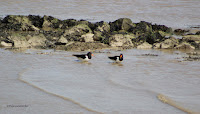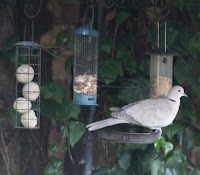Wading Birds of the Essex Mudflats
Essex has the longest shoreline of any county in the UK. Though the mudflats don’t always look pretty
on a dank winter day, it’s productive and food rich ecosystem is one of the
reasons that Essex welcomes so many wading bird species each winter.
 |
| Beautiful Godwits |
My personal favourites are the bar-tailed and black-tailed
Godwits. They are a large bird, and very pretty in breeding plumage. They form
large flocks along the shorelines as they probe the mud for invertebrates. Tiny
numbers of black-tailed godwits breed in the UK but they are on the UK
conservation red list. We see them here
in Essex as they over winter from their Icelandic breeding locations. Project Godwit is working hard to help this
beautiful bird’s long term future in the UK.
If you see a ringed bird, let them know!
Our mudflats also welcome large numbers of knot and dunlin
for the winter. Large flocks of
turnstone are common along Leigh seafront and near Southend pier. They are fascinating to watch as they scuttle
among the stones picking at the invertebrates that live under the seaweed. Sanderling can also sometimes be seen here on
the sandier beaches, running back and forth from the waves on the tide edge.
 |
| Dunlin looking for their dinner! |
Wintering avocets are seen along the coast forming distinctive
flocks. They are increasingly becoming a
summer visitor too which is lovely to see.
I regularly see them when I’m out with the official Blog Dog, they sift
through the mud with their delicate bills looking for food. Lapwing winter
here, they are easily identifiable in flight by their massive black and white
wings and flight pattern. They are a
declining breeder here.
Redshank are year round residents along the Essex
coast. In winter the 25,000 breeding UK
pairs become over 130,000 birds country wide when they are joined overwintering
Icelandic visitors. Redshank are
distinctive by their bright orangey red legs.
 |
| Mr and Mrs Oystercatcher |
Another resident is the eye-catching and noisy oystercatcher.
They are widespread along the coast line where they eat cockles and
mussels. Ringed plover are resident in
small numbers, sadly they too are on the red conservation list. They are easier to spot in winter as birds
from Europe join them, and bird from Canada and Greenland stop over as they
migrate.
As so many of the wading birds that we see in Essex need conservation
help, the work of organisations such as the Essex Wildlife Trust is vital. Our mudflats are a delicately balanced
ecosystem and they are adversely affected by pollution and shipping activity.
If our coastal environment is going to continue to support these birds we need
to protect the whole lifecycle, maintaining breeding spots, nesting grounds and
layover places for migrating numbers to feed up and rest on their epic journeys.


Comments
Post a Comment